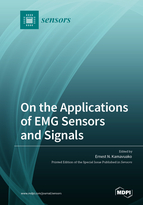On the Applications of EMG Sensors and Signals
A special issue of Sensors (ISSN 1424-8220). This special issue belongs to the section "Biosensors".
Deadline for manuscript submissions: closed (31 May 2022) | Viewed by 73983
Special Issue Editor
Interests: biological sensors/signals and their applications in prostheses; fluid quantification and monitoring; cardiology
Special Issues, Collections and Topics in MDPI journals
Special Issue Information
Electromyography (EMG) is a technique for evaluating and recording the electrical activity produced by muscles. EMG signals can be harvested on the surface of the skin, under the skin, and inside the muscle providing different levels of information. Over the last few decades, there have been considerable advances in sensor technologies, including miniaturization; enabling EMG sensors to have found applications in many areas including but not limited to electrodiagnostic medicine, robotics, rehabilitation (prostheses, assistive devices), hydration and nutrition, motion analysis, and modeling of handwriting.
This Special Issue attempts to capture the latest advances in EMG sensor development, EMG sensor applications, and EMG signal conditioning, from both theoretical and experimental approaches.
Dr. Ernest N. Kamavuako
Guest Editor
Manuscript Submission Information
Manuscripts should be submitted online at www.mdpi.com by registering and logging in to this website. Once you are registered, click here to go to the submission form. Manuscripts can be submitted until the deadline. All submissions that pass pre-check are peer-reviewed. Accepted papers will be published continuously in the journal (as soon as accepted) and will be listed together on the special issue website. Research articles, review articles as well as short communications are invited. For planned papers, a title and short abstract (about 100 words) can be sent to the Editorial Office for announcement on this website.
Submitted manuscripts should not have been published previously, nor be under consideration for publication elsewhere (except conference proceedings papers). All manuscripts are thoroughly refereed through a single-blind peer-review process. A guide for authors and other relevant information for submission of manuscripts is available on the Instructions for Authors page. Sensors is an international peer-reviewed open access semimonthly journal published by MDPI.
Please visit the Instructions for Authors page before submitting a manuscript. The Article Processing Charge (APC) for publication in this open access journal is 2600 CHF (Swiss Francs). Submitted papers should be well formatted and use good English. Authors may use MDPI's English editing service prior to publication or during author revisions.
Keywords
- Electromyography (EMG)
- Surface electromyogram (sEMG)
- Intramuscular EMG
- EMG sensors
- EMG signals
- EMG modelling
- EMG Feature extraction
- Pattern recognition
- Fluid estimation
- Prosthetics







